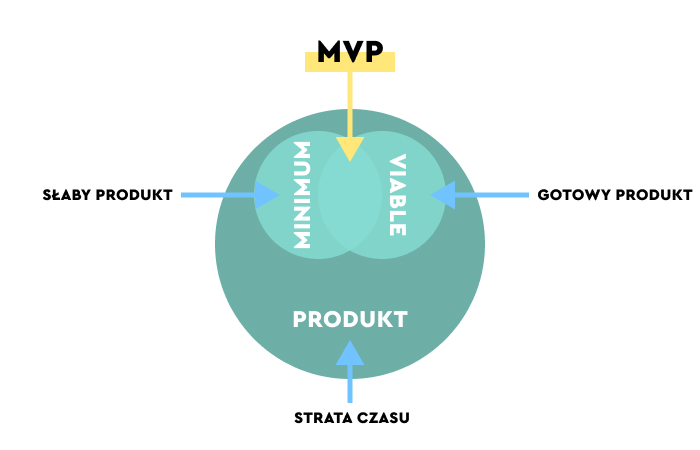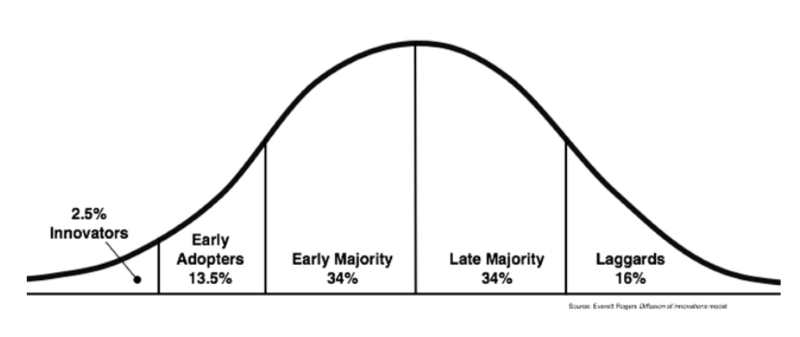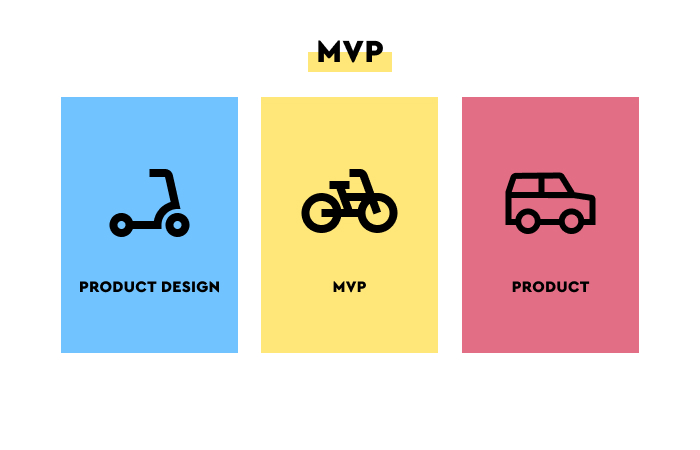According to a very concise definition, an MVP model (Minimum Viable Product) is an experiment to sift out business ideas that arouse market interest from the ones that don't.
If you have ever wondered what Minimum Viable Product means, what the acronym MVP stands for, and what role MVP UX Design plays in the process of designing, deploying, optimizing, and developing digital products. Then you have the best opportunity to find out.
This article will undoubtedly make terms such as product MVP, application MVP, and UX MVP more understandable.
What is hidden under the acronym MVP, and what is a product with core functionality? What is the use of products and digital services with minimum functionalities?
Why is it worth introducing to the market and offering users and customers products that have only basic functionality?
What kind of UX should products offered in the Minimum Viable Product formula provide?
Minimum Viable Products have become very popular, not only in the start-up domain. In the gaming industry, such solutions are also known and applied.
You should also remember that giants such as Facebook, Groupon, Airbnb, Amazon, and Dropbox began their market conquest with the MVP formula.
So let's take a closer look at the MVP's advantages, limitations, and conditionings.
We invite you to read on!
An MVP – what is it? A brief definition of Minimum Viable Product
Digital products created in the MVP model are often compared to samples offered to customers in other industries.
MVP is also compared to experimental scientific methods, in which research hypotheses are tested, verified, and falsified.
MVP is about business hypotheses and seeking feedback. It's about testing whether a business idea has a market justification – whether it will generate interest that will translate into satisfactory revenues and profits.
And we must say that these kinds of comparisons are very accurate.
That's because behind the MVP stands an idea that no concept is good enough on paper; no idea is convincing enough until it's confronted with users' needs.
At the same time, no idea; no product can be definitively crossed off on paper until you put it to the market test. Each product requires feedback/testing.
Of course, under conditions of minimum financial risks and a certain degree of design caution, reflected in limited time and limited commitment of resources.

Experimentation, minimizing risks, and seeking opportunities are perhaps the most important values and activities that drive business owners who want to start their market adventure with an MVP.
Alright, but what is an MVP?
What does MVP mean? According to the definition published in the article "Defining, developing, and building a minimum viable product (MVP)," a digital product with minimal usability, a product with core functionality, is simply the first version of a product fit for the market.
A Minimum Viable Product is a product that has the most basic functions that allow users to achieve the most elementary goals.
At the same time, the MVP becomes a tool for UX designers, programmers, developers, and UX researchers – it provides the necessary feedback and insight into the needs of its users. And this constitutes its value.
In contrast, according to Eric Ries' approach, presented on the Agile Alliance website, a Minimum Viable Product is treated as an initial version of a new product.
A version that allows the design, development, and research teams to collect a large amount of customer information with as little effort as possible.
Therefore, an MVP is a version of a product (e.g., an application) that is:
- Basic
- Operating to a limited extent
- Supporting functions that stem from a narrowly defined value proposition
- Addressed to a narrow audience (Innovators, Early Adopters)
- Flexible – allowing you to expand functionalities and quickly adapt a product to the market.
Benefits of creating an MVP – a product with core functionality
From the creation of a concept, a vision for a product (e.g., a mobile application, desktop software, a service provided to an online user) to its delivery to users, thanks to the MVP model, it doesn't take much time.
Short timeframes are one of the main factors behind the popularity of MVPs.
Equally attractive is the method of developing products with core functionality, usually conducted in agile methodologies (such as Agile or Lean Startup).
Iterations allow project, development, and research teams to educate themselves and propose solutions that users will be more interested in.
Moreover, the most important goals and benefits of the Minimum Viable Product are:
- Ability to test technology solutions, product functions, business models, and problems
- Surveying, discovering, and understanding needs and their determinants
- Acquiring arguments to make more accurate and effective business, technology, and UX decisions
- Discovering market niches
- Ensuring user satisfaction
- Ability to measure customer interest
- Ability to set up an optimal configuration of functionality, features, attributes, and mods (ways of working)
- Minimizing risk
- Optimizing and diversifying the budget
- Acquiring a significant amount of qualitative and quantitative data
- Opportunity to discover the rank of functions given by users of a digital product – it's not so rare that functions that developers regard as core are considered peripheral by users, and vice versa.
From a project and business perspective, harnessing the potential of MVPs also means being able to define priorities in workflows more accurately.
Managing a project, a product that is created in agile methodologies (and these are the ones in which minimum viable products – such as Lean Startup – are created) is much more:
- Rational
- Safe
- Economic
- Efficient – in terms of time and budget
- Trouble-free
- Focused on well-defined minor goals
- Faster
- Oriented towards customer needs that are better understood.
From a business point of view, the justification for deploying a product in the MVP formula is primarily:
- Ability to achieve higher retention of customers/users using an application
- Attracting user groups interested in innovative products (which is what a startup is associated with)
- Making business and project decisions based on data – Evidence-Based UX
- More accurate positioning, matching the digital product to the market
- Ability to respond faster to changing market conditions (MVP helps react to customer feedback and adapt the product to evolving priorities)
- Opportunity to gain a strategic market advantage
- Ability to determine the minimum profitability of a product
- Ability to minimize the time and resources required to create a digital product
- Possibility of avoiding unnecessary work and losing valuable time (in terms of production costs and timing – entering the market).
MVP is more than a prototype and something less than a complete product version; it's also a starting point indicating and correcting the future direction of digital product development.

When creating and developing a product in the MVP model, it's also worth considering the possible problems that arise.
The main risk is related to the possibility of making assessments and predictions based on wrong premises.
Changes made as part of MVP development should be driven by precise and consciously defined metrics and feedback that should take into account the differences between the following models:
- MVP (Minimum Viable Product), which focuses on validating business hypotheses, learning, and understanding user needs and problems
- MMF (Minimum Marketable Feature) focuses on the minimum set of features that represent any value to a customer
- MMP (Minimum Marketable Product) is oriented toward determining the profitability of a project.
The Minimum Viable Product is a model that protects business owners from wrong investment decisions and from creating products that customers will reject or will not enjoy sufficient business interest.
It's worth remembering that most startups fail to achieve market success for the most mundane reason – the digital product or service they offer doesn't spark interest and can't generate enough revenue.
Therefore, it's helpful to keep in mind that the success of a digital product depends on the refinement of three key features that a project in the MVP model should have.
Minimally useful and profitable products for users, customers must offer sufficiently attractive value to make them want to use it.
It needs to give a clear vision of future benefits, which will expand throughout product development and improvement.
The anticipated future benefits are a powerful attractor, but they also heavily determine user loyalty.
To retain customers, the product must communicate future values clearly and compellingly.
The intertwining of these factors and their mutual conditioning in a feedback loop is a necessary and sufficient condition for a product to have a chance for development and eventual success.
How to plan a minimally useful, profitable product?
The primary purpose and benefit of creating digital products in the MVP model is the ability to quickly and relatively inexpensively enter the market.
As a verification and validating tool, the MVP allows you to collect information, develop a product, program it (its features, attributes), and ensure its continued growth.
The important issue is establishing a balance between what the digital product offers users and what they actually need.

The MVP model makes it possible to optimize how needs are met. The development process (e.g., of a website) must be done based on clearly defined priorities, precise definitions, and adequate tools.
Above all, it is necessary to:
- Correctly diagnose the problem that the MVP is supposed to solve – it needs to be real and worth attention; it needs to be a problem for users, urgent enough to require adequate tools, methods, and means
- Accurately identify (in a qualitative and quantitative sense) the target group, people who experience the problem, are looking for a solution or at least are open to such a solution, ready to try it out
- Define how the MVP will solve the problem – illustrate its attractiveness, effectiveness, efficiency, accessibility, speed, ease, and cost
- Identify the needs and business objectives in different time perspectives
- Define criteria for success.
The target group of MVPs usually consists of so-called Early Adopters.
In the article published on the Interaction Design Foundation blog "Early Adopters," a group of such users, first-time customers, are defined as people who:
- Are among the first to use new products, services, or technologies
- Set and create trends (Trendsetters)
- Eagerly engage in product development – give spontaneous and active feedback, express opinions (e.g., recommend a program, praise its features)
- Recommend a product in an autonomous, unconditional, and selfless manner.
In addition, you should be aware of the variability of interest of product users during a product life cycle.
To understand this issue, the division of types of product users proposed by sociologist Everett Rogers in his book "Diffusion of Innovations" is very helpful.
The American researcher distinguished the following types of product users:
- Innovators they're willing to take risks, are open-minded and interested in testing new solutions, and like to make changes
- Early Adopters enjoy authority and have a strong influence in shaping the opinions and judgments of others
- Early Majority avoid risk and make consumer choices rationally and cautiously
- Late Majority are willing to purchase products and services that have been tried and tested by other users
- Laggards value traditional methods of operation and are very reluctant to embrace change and risk; their appearance usually suggests that a product isn't seen as innovative and is losing its current status.

Specific customer needs, approaches, goals, values, ways of doing things, thinking, and evaluating should be essential points of reference in the digital product development process.
The interest of different types of product users (including digital) coincides with a product life cycle.
But that's not all.
Although the MVP is a "stripped down" version of a product (not to be confused with a landing page), it's still a product that should be refined in terms of functionality and User Experience.
Its creation should follow the successive stages of digital product creation – the discovery phase, the strategy phase, the concept phase, the design phase, and the development phase.
The MVP model is directed towards education, understanding, data-driven development, and feedback; therefore, it's necessary to take care of the quality of information obtained from end users.
In the most basic and useful (design, technology, business) sense. You should collect the following:
- Qualitative infromation
- Quantitative infromation.
It's wrong to favor or omit any of these sources of information. You can only draw accurate, helpful, and valuable conclusions from data analyses of both sources.
You should remember that qualitative data allows you to understand how users react and how friendly, intuitive, useful, valuable, or, on the contrary, useless, worthless, or problematic the MVP is.
In turn, quantitative data allows you to understand the scope of the problem and discover the performance of a product to determine in a concrete way how big/small challenges the MVP poses to users.
Both data sources allow you to iterate and develop a digital product more effectively.

The entire process of obtaining feedback and incorporating it into the design-technology-business process should be circular.
What is an MVP? Summary
- What is an MVP? MVP is more than a prototype and something less than a complete product version. It's a starting point indicating the future direction of web or mobile app development.
- A Minimum Viable Product is a kind of experiment in which business ideas that arouse market interest are separated from those that don't.
- Digital products created in the MVP model are compared to samples and experimental scientific methods in which customers decide their value and usefulness.
- The ability to test business hypotheses, minimize risks, and look for opportunities usually motivate business owners to use the MVP model.
- A product with core functionality is the first version of a product that can be introduced to the market and can be presented to users without risk.
- Unlike complete products, an MVP has only basic functionalities (but it's not a prototype). Its production is cheap and fast.
- A Minimum Viable Product is a product that has the most basic functions that allow users to achieve the most elementary goals. (A landing page isn't an example of MVP).
- MVPs are often developed in one of the agile methodologies.
- Iterations help teams of specialists educate themselves and offer more relevant solutions to the target group.
- The Minimum Viable Product is a formula that protects business owners from wrong investment decisions.
- The market success of a digital product depends on whether the MVP will offer sufficiently compelling value to users and on introducing a clear vision of future benefits that will expand throughout product development.
- The MVP model (also IT MVP) is directed toward education, understanding, data-driven development, and feedback.



